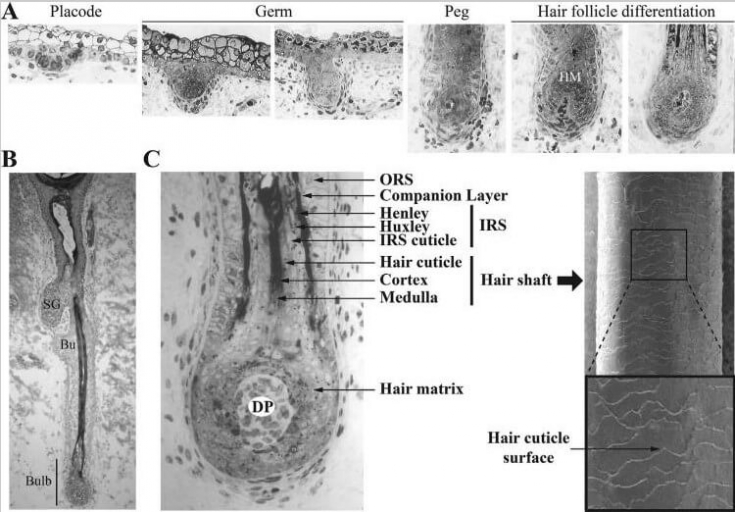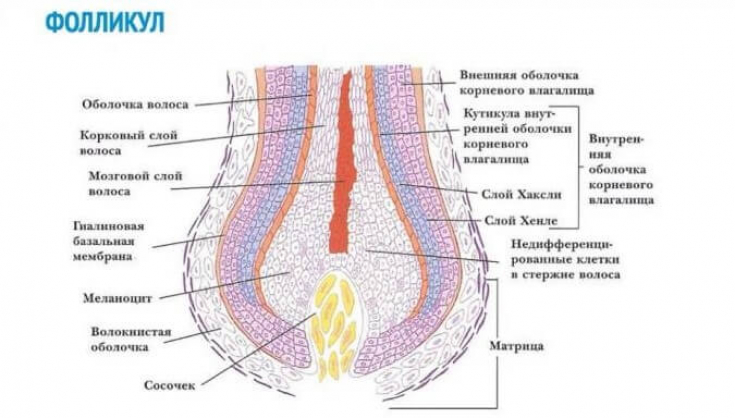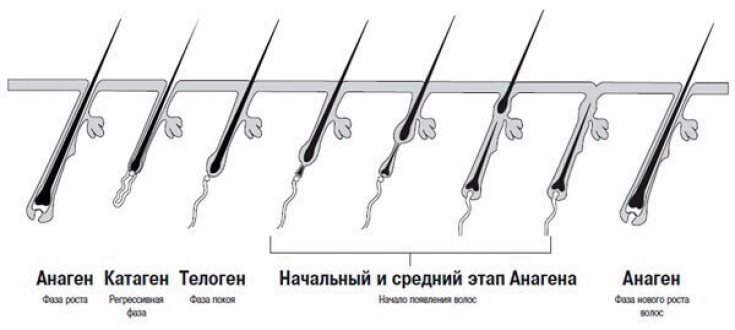In today's society the beauty of hair has acquired a special meaning, because now hair performs not so much a physiological function as an aesthetic one.
The more the doctor knows about the morphogenesis, structure and cycle of hair growth, the easier it is for him to choose the right treatment.
The fact is that different preparations act, respectively, on different phases of the hair growth cycle and on different structures of the hair itself.
On estet-portal.com we've looked into it in detail, how hair develops, starting from the prenatal period, what types of human hair, what are the features of the structure of hair, and also how it regeneration.
- Hair growth: morphogenesis and differentiation
- Features of the hair structure
- Human Hair Types
- Hair follicle regenerationa
Hair growth: morphogenesis and differentiation
The regulation of hair follicle development(HF) in the embryonic period and the cycling of HF growth in the postnatal period of life are highly conserved processes that are regulated by a similar series of signals between epithelial and mesenchymal cells.
Epithelial-mesenchymal interactions are the basis for the formation of epidermal appendages (hair, nails and sweat glands).
The initial morphological event in the development of HF is the thickening of the surface ectoderm with the formation placode (Fig. 1A).
This initial event is a response to a signal from the underlying mesenchyme.
Progression to the placode stage occurs with grouping of dermal cells adjacent to the placode resulting in the hair germ.
The hair germ proliferates and invaginates into the dermis, forming hair shaftwhere the condensed mesenchyme becomes dermal papilla (Fig. 1A).

Fig. 1: Morphogenesis, differentiation and hair structure.
(A) Sections of fetal hair follicles at the stages of placode, hair germ, hair shaft formation and VF differentiation (from 80 to 170 days).
(B) Full anagen WF on development day 126.
(C) 1. Left drawing: lower part of a hair follicle and human hair follicle area, depicting different hair compartments.
2. Right figure: Scanning electron microscopy of a human hair shaft.
Sequentialsignal from the dermal papilla to neighboring epidermal cells induces differentiation of the inner root sheath, in which the future hair shaft will develop .
Read also: T cells: hair growth activators
When the inner root sheath is formed, the epidermal cells that surround the dermal papilla, known as hair matrix cells, begin to differentiate into distinct lineages to formdifferent hair shaft structures that will grow within the inner root sheath and.
Features of hair structureThe hair follicle, which is usually associated with the sebaceous gland, can be divided into four main areas:
- infundibulum (funnel), which covers the hair from the surface of the skin to the junction with the sebaceous gland;
- isthmus - from the attachment of the muscle that raises the hair to the entrance to the lower part of the sebaceous duct;
root sheath ; - bulb , inside the concavity of which is the dermal papilla.
- The type of hair depends on the volume and shape of the dermal papilla.

the store of the stem cell population for the follicle. These bulging stem cells are essential for normal hair regeneration
, but can also colonize the interfollicular epidermisduring wound healing. Read also:
Mechanism of stem cell activation during hair follicle damageThe hair follicle consists of concentric sheaths
, each of which has its own functions and characteristics.These include supporting sheaths
that surround and stabilize the growing hair.Follow us on
Instagram, which is continuous with the basal layer of the epidermis, is the outermost layer of non-keratinizing follicle cells.Next, from outside to inside are the companion level
andthe inner root shell level. The inner root sheath has several compartments, the most peripheral being the layers of Henle
, thenthe layers of Huxley and finally the cuticle. The inner root sheath
ends at the junction between the isthmus and infundibulum.At the center of the follicle is the hair shaft
, which consists of the followingthree layers:
hair cuticle- which forms the surface of the hair;
- bark which forms the majority of the hair and is composed of keratinized cells that contain pigment from bulb melanocytes;
- The innermost oblong medulla , characterized by the presence of cells that differentiate and arrange themselves in one or more columns.
- Read the most interesting articles in
Telegram! Around the HF is a sheath of connective tissue
that supports the dermal papilla at the base of thefollicle. Human Hair Types
Hair covers almost the entire human body, with the exception of the skin on the palms, soles and lips. A person has different types of hair.Hair density is determined during fetal development and varies from person to person.
The first type of hair is formed in utero and is called
lanugo.
This is fine, unmedulated and lightly pigmented hair.
There are specialized types of hair, such as the hair that is found on the eyebrows, eyelashes, ears and nose, they are calledbristle
.Vlus hair
replaces lanugo at the end of pregnancy and is short, non-medulated and non-sebaceous hair.On the scalp, vellus hair is replaced with pigmented terminal hair
before or shortly after birth.Read also:
Human stem cells for hair regenerationOn the body, vellus hair is present throughout childhood and is replaced by terminal hair in certain areas of the body (arms, legs) during and after puberty.
The pituitary gland secretes hormones that trigger the production of androgens in the ovaries and testicles, promoting the replacement of vellus hair with coarse hair in the pubic and axillary regions.In addition, adult males develop terminal hair on the face and growldi.Following initial follicular morphogenesis, the hair follicle cycles through periodic stages that include
growth phase (anagen), regression phase (catagen) and resting phase (telogen)
.This cyclical regeneration is stem cell dependent
process that occurs throughout a person's life.The molecular signals underlying hair cycle reversal are similar to the formation of the placode during embryogenesis.
Duringanagen
- matrix cells proliferate and differentiate to form the inner root sheath and hair shaft.
- During catagen the epithelial compartment of the lower follicle, including matrix cells and differentiated layers, undergoes apoptosis, while the dermal papilla remains intact.
- The follicle then enters a resting telogen phase, after which the dermal papilla cells stimulate stem cell activation and hair matrix cell division for a new hair growth cycle.
 The length of the hair growth cycle varies depending on the location on the body.
The length of the hair growth cycle varies depending on the location on the body.
in the anagen phase,
which lasts2–6 years, while the catagen phase ;and Read also: The causes of baldness: scientists have discovered new aspects at the cellular level Human hair growth is not synchronized, so different stages occur simultaneously in different follicles.
Subscribe to our YouTube-channel!







Add a comment